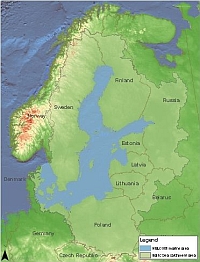Supplement 1.1d: The Convention on the Protection of the Marine Environment of the Baltic Sea Area
Short: The Helsinki Convention
The Baltic is home to many species of plants, animals and microorganisms in a great variety of different habitats. Most of these are at risk from human activity, and many Baltic fish populations are now thought to be dangerously low.
Among the main threats are eutrophication caused primarily by excess nitrogen and phosphorus in the water; pollution by hazardous substances including pesticides, heavy metals and industrial wastes; habitat destruction; the use of certain harmful fishing equipment, and the introduction of alien invasive species.
On 24 March 1974 the Convention on the Protection of the Marine Environment of the Baltic Sea Area,
known as the 1974 Helsinki Convention, was signed by the then seven Baltic coastal states. It was the first time ever
that all the sources of pollution, whether from land, sea or air, around an entire sea were made subject to a single convention.
The 1974 Convention entered into force on 3 May 1980.
It was concerned primarily with issues of technical pollution control and the pollution of the Baltic Sea as such.
The present version of the convention was signed in 1992 by all the states bordering on the Baltic Sea, and the European Community.
After ratification the Convention entered into force on 17 January 2000.
The 1992 Helsinki Convention is concerned with the entire marine environment of the Baltic Sea area.
Its purpose is to prevent and eliminate pollution in order to promote the ecological restoration of the Baltic Sea area and the preservation
of its ecological balance. Its geographical scope covers not only the entire Baltic Sea including the seafloor and coastal zones, but also its drainage area.
Contracting parties:
All nine Baltic Sea states (Denmark, Estonia, Finland, Germany, Latvia, Lithuania, Poland, Russia, Sweden) and the EU.
To attain the joint conservation goals, the Helsinki Commission (HELCOM) was created. This body meets annually. Recommendations on environmental and conservation issues which are to be implemented by the parties are an important instrument of HELCOM. The commission is supported by working groups on the various aspects of the convention. Further activities include monitoring programmes and status reports. Important outcomes of conservation activities include the development of a system of Baltic Sea Protected Areas (BSPAs) and the production of a first red list of endangered habitat types of the Baltic Sea.
Since 1992, more than 34 of the 132 serious pollution areas - so called hot spots - identified around the Baltic Sea have been cleaned up. Nevertheless, concentrations of PCBs and DDT remain much higher in the Baltic than in the North Sea or the open Atlantic Ocean. HELCOM put a Hazardous Substances Project team to work in 1998 to reduce discharges, emissions and losses of hazardous substances in the Baltic Sea drainage basin through 2020, and selected 42 hazardous substances for immediate priority action.
The complete Helsinki Convention is available in pdf format from the HELCOM web page (external links):
1974 Covention (88 KB)1992 Convention (last amended 1 July 2004) (608 KB)


